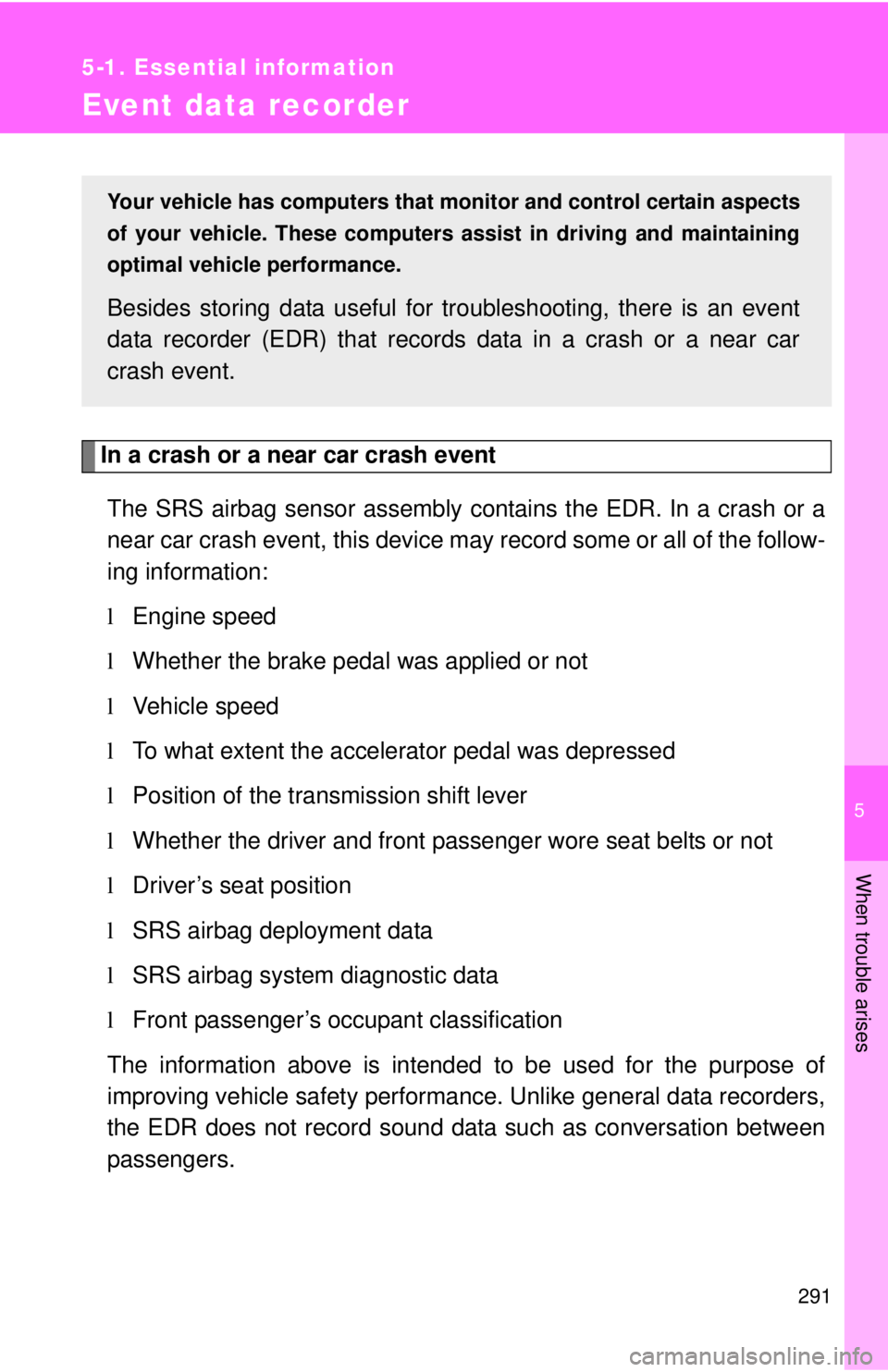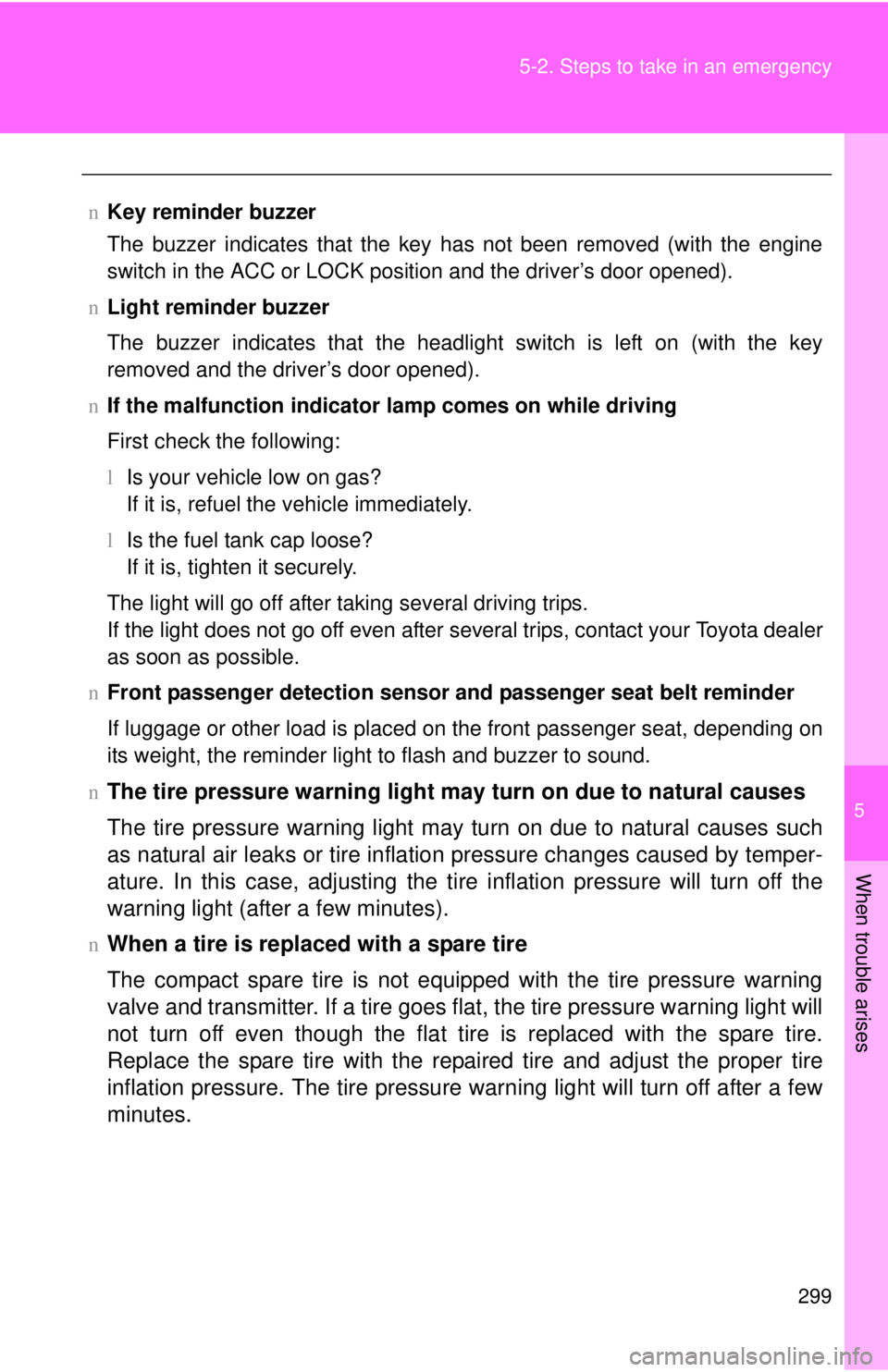2009 TOYOTA YARIS SEDAN sensor
[x] Cancel search: sensorPage 61 of 388

45
1-3. Adjustable components (s
eats, mirrors, steering wheel)
1
Before driving
CAUTION
nWearing a seat belt
lDo not recline the seat any more than necessary to achieve a proper seat-
ing position. The seat belt is most effective when the occupants are sitting
up straight and well back in the seats.
l Do not wear the shoulder belt under your arm.
l Always wear your seat belt low and snug across your hips.
n Adjustable shoulder anchor
Always make sure the shoulder belt is positioned across the center of your
shoulder. The belt should be kept away from your neck, but not falling off
your shoulder. Failure to do so could reduce the amount of protection in an
accident and cause death or serious injuries in a collision. ( →P. 41)
n Seat belt pretensioners
lDo not place anything, such as a cushion, on the front passenger’s seat.
Doing so will disperse the passenger’s weight, which prevents the sensor
from detecting the passenger’s weight properly. As a result, the seat belt
pretensioner for the front passenger’s seat may not activate in the event of
a collision.
l If the pretensioner has activated, the seat belt becomes locked: it cannot
be further extended, nor will it return to the stowed position. The seat belt
cannot be used again and must be replaced at your Toyota dealer.
n Seat belt damage and wear
lDo not damage the seat belts by allowing the belt, plate, or buckle to be
jammed in the door.
l Inspect the seat belt system periodically. Check for cuts, fraying, and loose
parts. Do not use a damaged seat belt until it is replaced. Damaged seat
belt cannot protect an occupant from death or serious injury.
l Ensure that the belt and tab are locked and the belt is not twisted.
If the seat belt does not function correctly, immediately contact your Toyota
dealer.
l Replace the seat assembly, including the belts, if your vehicle has been
involved in a serious accident, even if there is no obvious damage.
Page 82 of 388

66 1-7. Safety information
Airbag system componentsFront passenger airbag
Curtain shield airbags (if
equipped)
Side airbags (if equipped)
SRS warning light
Curtain shield airbag sen-
sors (if equipped)
Driver airbag
Side and curtain shield air-
bag sensors (if equipped) Driver’s seat position sen-
sor
Driver’s seat belt buckle
switch
AIR BAG ON and AIR BAG
OFF indicator lights
Front airbag sensors
Airbag sensor assembly
Front passenger’s seat belt
buckle switch
Occupant detection system
(ECU and sensors)
Page 83 of 388

67
1-7. Safety information
1
Before driving
Your vehicle is equipped with
ADVANCED AIRBAGS designed based
on US motor vehicle safety standards (FMVSS208). The airbag sys-
tem controls airbag deployment po wer for the driver and front pas-
senger. The driver airbag system consists of the driver seat’s position
sensor etc. The front passenger’s airbag system consists of the front
passenger occupant classification sensor etc.
The main SRS airbag system components are shown above. The
SRS airbag system is controlled by the airbag sensor assembly. The
airbag sensor assembly consists of a safing sensor and an airbag
sensor.
In certain types of severe frontal or side impacts, the SRS airbag sys-
tem triggers the airbag inflators. A chemical reaction in the inflators
quickly fills the airbags with non-toxic gas to help rest rain the motion
of the occupants.
n SRS warning light
This warning light system monitors the airbag sensor assembly, front airbag
sensors, side and curtain shield airbag sensors, curtain shield airbag sen-
sors, driver’s seat position sensor, driver’s seat belt buckle switch, front pas-
senger occupant classification system, AIR BAG ON indicator light, AIR
BAG OFF indicator light, front passenger’s seat belt buckle switch, seat belt
pretensioner assemblies, inflators, interconnecting wiring and power
sources. ( →P. 294)
n If the SRS airbags deploy (inflate)
lBruising and slight abrasions may result from contact with a deploying
(inflating) SRS airbag.
l A loud noise and white powder will be emitted.
l Vehicles with side and curtain shield airbags: Parts of the airbag module
(steering wheel hub, airbag cover and inflator) as well as the front seats,
and parts of the front and rear pillars and roof side rail, may be hot for
several minutes. The airbag itself may also be hot.
l Vehicles without side and curtain shield airbags: Parts of the airbag mod-
ule (steering wheel hub, airbag cover and inflator) as well as the front
seats may be hot for several minutes. The airbag itself may also be hot.
Page 303 of 388

5
When trouble arises
291
5-1. Essential information
Event data recorder
In a crash or a near car crash eventThe SRS airbag sensor assembly contains the EDR. In a crash or a
near car crash event, this device may record some or all of the follow-
ing information:
l Engine speed
l Whether the brake pedal was applied or not
l Vehicle speed
l To what extent the accelerator pedal was depressed
l Position of the transmission shift lever
l Whether the driver and front passenger wore seat belts or not
l Driver’s seat position
l SRS airbag deployment data
l SRS airbag system diagnostic data
l Front passenger’s occupant classification
The information above is intended to be used for the purpose of
improving vehicle safety performance. Unlike general data recorders,
the EDR does not record sound data such as conversation between
passengers.
Your vehicle has computers that monitor and control certain aspects
of your vehicle. These computers assi st in driving and maintaining
optimal vehicle performance.
Besides storing data useful for tr oubleshooting, there is an event
data recorder (EDR) that records data in a crash or a near car
crash event.
Page 311 of 388

5
When trouble arises
299
5-2. Steps to take in an emergency
n
Key reminder buzzer
The buzzer indicates that the key has not been removed (with the engine
switch in the ACC or LOCK position and the driver’s door opened).
n Light reminder buzzer
The buzzer indicates that the headlight switch is left on (with the key
removed and the driver’s door opened).
n If the malfunction indicator lamp comes on while driving
First check the following:
l Is your vehicle low on gas?
If it is, refuel the vehicle immediately.
l Is the fuel tank cap loose?
If it is, tighten it securely.
The light will go off after taking several driving trips.
If the light does not go off even after several trips, contact your Toyota dealer
as soon as possible.
n Front passenger detection sensor and passenger seat belt reminder
If luggage or other load is placed on the front passenger seat, depending on
its weight, the reminder light to flash and buzzer to sound.
n
The tire pressure warning light may turn on due to natural causes
The tire pressure warning light may turn on due to natural causes such
as natural air leaks or tire inflation pressure changes caused by temper-
ature. In this case, adjusting the ti re inflation pressure will turn off the
warning light (after a few minutes).
nWhen a tire is replaced with a spare tire
The compact spare tire is not equipped with the tire pressure warning
valve and transmitter. If a tire goes flat, the tire pressure warning light will
not turn off even though the flat tire is replaced with the spare tire.
Replace the spare tire with the repair ed tire and adjust the proper tire
inflation pressure. The ti re pressure warning light will turn off after a few
minutes.
Page 377 of 388

369
Alphabetical index
Power door lock switch........... 26
Power window switch ............. 52
Turn signal lights .................. 113
Window lock switch ................ 53
Wiper and washer ................ 129
Tachometer .............................. 117
Tail lights Indicator................................ 126
Replacing light bulbs ............ 270
Switch ................................... 126
Wattage ................................ 337
Theft deterrent system
Alarm ...................................... 60
Engine immobilizer system..... 58
Theft prevention labels ........... 62
Theft prevention labels ............. 62
Tire inflation pressure ............ 248
Tire information Glossary ............................... 348
Size ...................................... 345
Tire identification number ..... 344
Uniform tire quality grading ............................... 346
Tires
Chains .................................. 141
Checking .............................. 242
If you have a flat tire ............. 303
Identification number ............ 341
Inflation pressure .......... 248, 336
Inflation pressure sensor ...... 243
Information ........................... 341
Replacing ..................... 242, 303
Rotating tires ........................ 242
Size ...................................... 336
Snow tires............................. 141
Spare tire .............................. 303
Tire pressure warningsystem........................ 242, 296
Warning light ........................ 296
Tools......................................... 303
Total load capacity .................. 140 Towing
Dinghy towing................153, 154
Emergency towing.................283
Trailer towing.................144, 145
Trip meter .................................120
Trunk ...........................................31
Trunk light Wattage .................................337
Turn signal lights Indicator ................................113
Lever .....................................113
Replacing light bulbs .............270
Switch....................................113
Wattage .................................337
Vanity mirrors...........................201
Vehicle identification number ...................................329
Warning buzzers Brake system ........................293
Seat belt reminder .................296
Warning lights ABS .......................................294
Airbag system .......................294
Anti-lock brake system ..........294
Brake system ........................293
Charging system .... ...............294
Driver’s seat belt ...................296
Electric power steering system ................................294
Electronic engine control system ................................294
Engine oil replacement..........296
EPS system...........................294
Front passenger occupant classification system ...........294
Front passenger’s seat belt ...296
High engine coolant temperature ........................294
Low brake fluid ......................293
Low engine oil pressure ........294
T
V
W